Papers by Sanja Budisavljevic
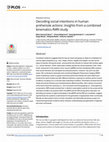
Consistent evidence suggests that the way we reach and grasp an object is modulated not only by o... more Consistent evidence suggests that the way we reach and grasp an object is modulated not only by object properties (e.g., size, shape, texture, fragility and weight), but also by the types of intention driving the action, among which the intention to interact with another agent (i.e., social intention). Action observation studies ascribe the neural substrate of this 'inten-tional' component to the putative mirror neuron (pMNS) and the mentalizing (MS) systems. How social intentions are translated into executed actions, however, has yet to be addressed. We conducted a kinematic and a functional Magnetic Resonance Imaging (fMRI) study considering a reach-to-grasp movement performed towards the same object positioned at the same location but with different intentions: passing it to another person (social condition) or putting it on a concave base (individual condition). Kinematics showed that individual and social intentions are characterized by different profiles, with a slower movement at the level of both the reaching (i.e., arm movement) and the grasping (i.e., hand aperture) components. fMRI results showed that: (i) distinct voxel pattern activity for the social and the individual condition are present within the pMNS and the MS during action execution; (ii) decoding accuracies of regions belonging to the pMNS and the MS are correlated, suggesting that these two systems could interact for the generation of appropriate motor commands. Results are discussed in terms of motor simulation and inferential processes as part of a hierarchical generative model for action intention understanding and generation of appropriate motor commands.
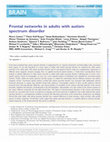
It has been postulated that autism spectrum disorder is underpinned by an 'atypical connectivity'... more It has been postulated that autism spectrum disorder is underpinned by an 'atypical connectivity' involving higher-order association brain regions. To test this hypothesis in a large cohort of adults with autism spectrum disorder we compared the white matter networks of 61 adult males with autism spectrum disorder and 61 neurotypical controls, using two complementary approaches to diffusion tensor magnetic resonance imaging. First, we applied tract-based spatial statistics, a 'whole brain' non-hypothesis driven method, to identify differences in white matter networks in adults with autism spectrum disorder. Following this we used a tract-specific analysis, based on tractography, to carry out a more detailed analysis of individual tracts identified by tract-based spatial statistics. Finally, within the autism spectrum disorder group, we studied the relationship between diffusion measures and autistic symptom severity. Tract-based spatial statistics revealed that autism spectrum disorder was associated with significantly reduced fractional anisotropy in regions that included frontal lobe pathways. Tractography analysis of these specific pathways showed increased mean and perpendicular diffusivity, and reduced number of streamlines in the anterior and long segments of the arcuate fasciculus, cingulum and uncinate—predominantly in the left hemisphere. Abnormalities were also evident in the anterior portions of the corpus callosum connecting left and right frontal lobes. The degree of microstructural alteration of the arcuate and uncinate fasciculi was associated with severity of symptoms in language and social reciprocity in childhood. Our results indicated that autism spectrum disorder is a developmental condition associated with abnormal connectivity of the frontal lobes. Furthermore our findings showed that male adults with autism spectrum disorder have regional differences in brain anatomy, which correlate with specific aspects of autistic symptoms. Overall these results suggest that autism spectrum disorder is a condition linked to aberrant developmental trajectories of the frontal networks that persist in adult life.
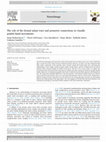
A B S T R A C T Functional neuroimaging and brain lesion studies demonstrate that secondary motor... more A B S T R A C T Functional neuroimaging and brain lesion studies demonstrate that secondary motor areas of the frontal lobe play a crucial role in the cortical control of hand movements. However, no study so far has examined frontal white matter connections of the secondary motor network, namely the frontal aslant tract, connecting the supplementary motor complex and the posterior inferior frontal regions, and the U-shaped dorsal and ventral premotor fibers running through the middle frontal gyrus. The aim of the current study is to explore the involvement of the short frontal lobe connections in reaching and reach-to-grasp movements in 32 right-handed healthy subjects by correlating tractography data based on spherical deconvolution approach with kinematical data. We showed that individual differences in the microstructure of the bilateral frontal aslant tract, bilateral ventral and left dorsal premotor tracts were associated with kinematic features of hand actions. Furthermore, bilateral ventral premotor connections were also involved in the closing grip phase necessary for determining efficient and stable grasping of the target object. This work suggests for the first time that hand kinematics and visuomotor processing are associated with the anatomy of the short frontal lobe connections.
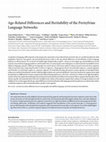
The Journal of neuroscience : the official journal of the Society for Neuroscience, Jan 16, 2015
Acquisition of language skills depends on the progressive maturation of specialized brain network... more Acquisition of language skills depends on the progressive maturation of specialized brain networks that are usually lateralized in adult population. However, how genetic and environmental factors relate to the age-related differences in lateralization of these language pathways is still not known. We recruited 101 healthy right-handed subjects aged 9-40 years to investigate age-related differences in the anatomy of perisylvian language pathways and 86 adult twins (52 monozygotic and 34 dizygotic) to understand how heritability factors influence language anatomy. Diffusion tractography was used to dissect and extract indirect volume measures from the three segments of the arcuate fasciculus connecting Wernicke's to Broca's region (i.e., long segment), Broca's to Geschwind's region (i.e., anterior segment), and Wernicke's to Geschwind's region (i.e., posterior segment). We found that the long and anterior arcuate segments are lateralized before adolescence and ...
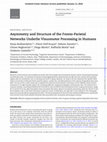
Research in both humans and monkeys has shown that even simple hand movements require cortical co... more Research in both humans and monkeys has shown that even simple hand movements require cortical control beyond primary sensorimotor areas. An extensive functional neuroimaging literature demonstrates the key role that cortical fronto-parietal regions play for movements such as reaching and reach-to-grasp. However, no study so far has examined the specific white matter connections linking the fronto-parietal regions, namely the 3 parallel pathways of the superior longitudinal fasciculus (SLF). The aim of the current study was to explore how selective fronto-parietal connections are for different kinds of hand movement in 30 right-handed subjects by correlating diffusion imaging tractography and kinematic data. We showed that a common network, consisting of bilateral SLF II and SLF III, was involved in both reaching and reach-to-grasp movements. Larger SLF II and SLF III in the right hemisphere were associated with faster speed of visuomotor processing, while the left SLF II and SLF III played a role in the initial movement trajectory control. Furthermore, the right SLF II was involved in the closing grip phase necessary for efficient grasping of the object. We demonstrated for the first time that individual differences in asymmetry and structure of the fronto-parietal networks were associated with visuomotor processing in humans.
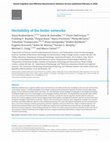
Individual differences in cognitive ability and social behaviour are influenced by the variabilit... more Individual differences in cognitive ability and social behaviour are influenced by the variability in the structure and function of the limbic system. A strong heritability of the limbic cortex has been previously reported, but little is known about how genetic factors influence specific limbic networks. We used diffusion tensor imaging tractography to investigate heritability of different limbic tracts in 52 monozygotic and 34 dizygotic healthy adult twins. We explored the connections that contribute to the activity of three distinct functional limbic networks, namely the dorsal cingulum ('medial default-mode net-work'), the ventral cingulum and the fornix ('hippocampal-diencephalic-retrosplenial network') and the uncinate fasciculus ('temporo-amygdala-orbitofrontal network'). Genetic and environmental variances were mapped for multiple tract-specific measures that reflect different aspects of the underlying anatomy. We report the highest heritability for the uncinate fascic-ulus, a tract that underpins emotion processing, semantic cognition, and social behaviour. High to moderate genetic and shared environmental effects were found for pathways important for social behaviour and memory, for example, fornix, dorsal and ventral cingulum. These findings indicate that within the limbic system inheritance of specific traits may rely on the anatomy of distinct networks and is higher for fronto-temporal pathways dedicated to complex social behaviour and emotional processing.
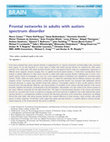
It has been postulated that autism spectrum disorder is underpinned by an 'atypical connectivity'... more It has been postulated that autism spectrum disorder is underpinned by an 'atypical connectivity' involving higher-order association brain regions. To test this hypothesis in a large cohort of adults with autism spectrum disorder we compared the white matter networks of 61 adult males with autism spectrum disorder and 61 neurotypical controls, using two complementary approaches to diffusion tensor magnetic resonance imaging. First, we applied tract-based spatial statistics, a 'whole brain' non-hypothesis driven method, to identify differences in white matter networks in adults with autism spectrum disorder. Following this we used a tract-specific analysis, based on tractography, to carry out a more detailed analysis of individual tracts identified by tract-based spatial statistics. Finally, within the autism spectrum disorder group, we studied the relationship between diffusion measures and autistic symptom severity. Tract-based spatial statistics revealed that autism spectrum disorder was associated with significantly reduced fractional anisotropy in regions that included frontal lobe pathways. Tractography analysis of these specific pathways showed increased mean and perpendicular diffusivity, and reduced number of streamlines in the anterior and long segments of the arcuate fasciculus, cingulum and uncinate—predominantly in the left hemisphere. Abnormalities were also evident in the anterior portions of the corpus callosum connecting left and right frontal lobes. The degree of microstructural alteration of the arcuate and uncinate fasciculi was associated with severity of symptoms in language and social reciprocity in childhood. Our results indicated that autism spectrum disorder is a developmental condition associated with abnormal connectivity of the frontal lobes. Furthermore our findings showed that male adults with autism spectrum disorder have regional differences in brain anatomy, which correlate with specific aspects of autistic symptoms. Overall these results suggest that autism spectrum disorder is a condition linked to aberrant developmental trajectories of the frontal networks that persist in adult life.
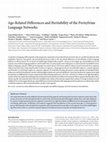
Acquisition of language skills depends on the progressive maturation of specialized brain network... more Acquisition of language skills depends on the progressive maturation of specialized brain networks that are usually lateralized in adult population. However, how genetic and environmental factors relate to the age-related differences in lateralization of these language pathways is still not known. We recruited 101 healthy right-handed subjects aged 9 -40 years to investigate age-related differences in the anatomy of perisylvian language pathways and 86 adult twins (52 monozygotic and 34 dizygotic) to understand how heritability factors influence language anatomy. Diffusion tractography was used to dissect and extract indirect volume measures from the three segments of the arcuate fasciculus connecting Wernicke's to Broca's region (i.e., long segment), Broca's to Geschwind's region (i.e., anterior segment), and Wernicke's to Geschwind's region (i.e., posterior segment). We found that the long and anterior arcuate segments are lateralized before adolescence and their lateralization remains stable throughout adolescence and early adulthood. Conversely, the posterior segment shows right lateralization in childhood but becomes progressively bilateral during adolescence, driven by a reduction in volume in the right hemisphere. Analysisofthetwinsampleshowedthatgeneticandsharedenvironmentalfactorsinfluencetheanatomyofthosesegmentsthatlateralizeearlier, whereas specific environmental effects drive the variability in the volume of the posterior segment that continues to change in adolescence and adulthood. Our results suggest that the age-related differences in the lateralization of the language perisylvian pathways are related to the relative contribution of genetic and environmental effects specific to each segment.
Cortex
Journal homepage: www.elsevier.com/locate/cortex c o r t e x 4 8 ( 2 0 1 2 ) 2 6 e3 5 0010-9452/$... more Journal homepage: www.elsevier.com/locate/cortex c o r t e x 4 8 ( 2 0 1 2 ) 2 6 e3 5 0010-9452/$ e see front matter ª








Uploads
Papers by Sanja Budisavljevic